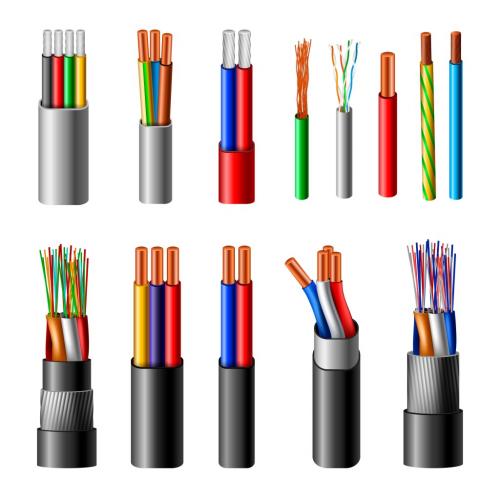Where To Buy Power Cable?

Electrical power cable is a type of cable that is used for electrical energy transmission and distribution. Two or more electrical conductors are joined by an over-sheath to form a power cable. It is used to transmit extremely high voltages in locations where overhead lines are impractical to utilise, like the sea, above an airport, etc. One of the main disadvantages of electrical power cable is that underground cable is more expensive than aerial cable for the same voltage.
Any electrical network's nerve centre is its electrical cables. In each electrification project, cables make up a significant portion of the capital outlay. They are also the most susceptible to failure. The majority of cable failures could be attributable to poor choices. The purpose of this essay is to discuss the subject of choosing electrical power cables properly.
Cable Construction
The conductor, dielectric, and sheath are the three primary parts of the power cable.
The cable's conductor acts as the current's conducting path. The dielectric or insulation protects the conductor from extraneous things and can bear the service voltage. The sheath shields the cables from any outside impacts, including fire, chemical or elector-chemical attack, and moisture intrusion. Every Electrical Cable Manufacturer uses different construction methods.
Conductor
Since copper and aluminium wires have a high electrical conductivity, they are employed as conductor materials in cables. A power cable is built from a single solid wire or several bare copper or aluminium wires.
A conductor with more than three wires is organized with six wires in the first layer, twelve in the second, eighteen in the third, and so on. The conductors have 7, 19, 37, 61, 91, etc. wires in them. The conductor's size is denoted by the fractions 7/A, 19/B, 37/C, etc., where the first number denotes the number of strands and the second figure, A, B, C, etc., denotes the diameters in cm or mm of the conductor.
Insulation
Impregnated paper, butty rubber, polyvinyl chloride cable, polyethylene, and cross-linked polyethylene are the most frequently used dielectrics in power cables. The main reasons why paper-insulated cables are preferred are their high current carrying capability, general dependability, and long life. The cable's dielectric compound should possess the qualities listed below.
• High insulation resistance is required for the insulator.
• To prevent leakage current from passing through it, it needs to have a high dielectric strength.
• The substance must be mechanically strong.
• The dielectric substance ought to be able to function at high temperatures.
• Low thermal resistance is required.
• The power factor should be low.
Synthetic dielectrics such as polyvinyl chloride, polyethylene, etc. should be employed in the cables used for damp soil and undersea applications. These materials have a nonmigratory dielectric and are relatively lightweight. Such a dielectric material also features a strong dielectric core, little power loss, and little heat resistance.
Inside Sheath
It serves to shield the cable from moisture that can damage the insulation. Lead alloy is used to make cable sheaths, and due to its strength, these cables can endure internal stresses. Nonmagnetic material ought to be used for the inner sheath.
Protective Garments
When placed directly on the ground, lead-sheathed cables are harmed by corrosion and electrolyte. Layers of fibrous material, such as paper, hessian, etc., or polyvinyl chloride, are used to protect the cables against corrosion. Serving refers to the fibre layers that are applied to the exterior of the electrical cable together with the waterproofing substance.
Armouring
To protect a sheath from mechanical harm, layers of galvanized steel wires or two layers of metal tape are put over the sheath. Because the steel wires have a high longitudinal strength, they are typically utilized for armoring. The wire is earthed using armoring as well. When a cable fault (caused by insulation failure) arises, the fault current passes through the armour and is earthed.
Over Sheath
It provides the cables with mechanical strength. It guards the cable against general wear and tear such as moisture, corrosion, dirt, and dust. The sheath is made from a thermosetting or thermoplastic polymer.
Things to Consider Before Choosing an Electrical Cable Company
Voltage Rating: This is the system's rated voltage for the cable to be placed and used at. It's also crucial to understand how to build a system. The cable's rated voltage is typically indicated as a dual rating, such as 6.6kV (UE) or 11kV (E).
The designation "UE" denotes the cable's suitability for usage at the given voltage in an uncovered or ineffectively earthed system. The letter "E" indicates that the cable can be used in a fully earthed system for the given voltage. Therefore, a cable with a rated voltage of 6.6 kV (UE) or 11 kV (E) can be utilized in systems that are 6.6 kV unearthed, 6.6 kV non-effectively earthed, or 11 kV solidly earthed.
Based on Conductor Type
Copper or aluminium are the two conductor types that are most frequently used in cables. As is well known, the continuous current rating, the short time current rating, and the cost per unit length of a copper cable are significantly higher than those of an aluminium cable for the same voltage rating, type, insulation, cross sectional area, and method of installation.
Based on The Type of Insulation
The majority of cables in use today are either PVC- or Insulated. Evidently, the continuous current rating, the short-time current rating, and the cost per unit length of an XLPE insulated cable are significantly higher than those of a PVC insulated cable for the same conductor material, voltage rating, type, insulation, cross-sectional area, and method of installation.
Types of Cables used
- Armoured or non-armored cables Unarmed cables are used in above-ground and indoor installations such as cable trays, ditches made of pre-cast concrete, etc. Any subterranean cable installation must use armored cables.
- The Armour may be a wire or a strip made of aluminium or galvanized iron. Frequently, this Armour is only connected to the plant's earthing system at one end, usually the sending end.
- The voltage level for which a cable is constructed and the insulation material—paper, cotton, rubber, etc.—are essentially what determine the type of cable.
Where Can I Buy Power Cables?
The best appliances to transmit electricity and communications signals are wires and cables in any electrical circuit. Znergy Cable's highest quality wires and cables now provide greater electrical appliance safeguards. Your astonishing hunt for a large variety of wires and cables in various sorts and brands may be solved in one place with Znergy Cable. Being one of the best suppliers, dealers, and distributors of electrical power cables online in India, we are dedicated to offering customers the best brands and products at the best prices.
Our catalogue is set up with easy-to-use features that enable you to quickly choose items from your list of desired wires and cables so that you may begin your online shopping for wires and cables. so as to respect your time
Znergy Cable is one of the best Cable Manufacturers in Australia. In order to save you time, we have listed quick access to single-core cables, pair cables, multicore cables, and accessories. These goods match your precise requirements and are available at the exact specifications you need. Buy wires and cables from your most trusted brands, like Znergy Cable.
Advertise on APSense
This advertising space is available.
Post Your Ad Here
Post Your Ad Here


Comments